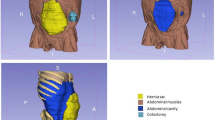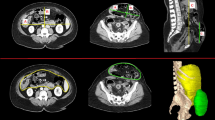Abstract
Objective
To evaluate 3D reconstruction through CT in the measurement of abdominal cavity volume.
Methods
From January 1, 2019 to December 31, 2019, 61 patients diagnosed as external abdominal hernia were included in this prospective study. Multislice computed tomography (MSCT) was applied to patients scanning, and the images were transferred to post-processing workstation for further analysis. We measured the abdominal cavity volumes using volume rendering (VR) method and diameter rendering (DR) method, and the results were used to test whether there is a correlation between them. In addition, the time required for the measurement was recorded and analyzed.
Results
In this study, we found that there was no significant difference in the abdominal cavity volumes between these two groups (VR vs. DR = 7857.316 ± 2035.786 cm3 vs. 7967.268 ± 2925.792 cm3, P > 0.05). Besides, the correlation analysis between the measured values of VR method and DR method showed there was a significant positive correlation (r = 0.922, P < 0.01). The linear regression equation based on the scatter plot was established as follows: y = 0.6417x + 2745, R2 = 0.8504. Furthermore, this regression equation was simplified as follows: y = 0.64x + 2800, R2 = 0.8499. Meanwhile, the time required for measurement of VR was significantly longer than that of DR (VR vs. DR = 64.3 ± 7.1 min vs. 2.6 ± 0.6 min, P < 0.01).
Conclusion
In conclusion, the DR method can quickly measure and calculate the abdominal cavity volume, and its accuracy can more suitable for clinical requirement.





Similar content being viewed by others
References
Rosen MJ (2018) We have a long way to go. Invited comment to: a systematic methodological review of reported perioperative variables, postoperative outcomes and hernia recurrence from randomized controlled trials of elective ventral hernia repair: clear definitions and standardized datasets are needed. Samuel G. Parker, C. P. J. Wood, J. W. Butterworth, R. W. Boulton, A. A. O. Plumb, S. Mallett, S. Halligan, A. C. J. Windsor. Hernia 22(2):227–228
Passot G et al (2016) Definition of giant ventral hernias: development of standardization through a practice survey. Int J Surg 28:136–140
Hunt L et al (2014) Management of intra-abdominal hypertension and abdominal compartment syndrome: a review. J Trauma Manag Outcomes 8(1):2–2
Parker SG et al (2019) What exactly is meant by “Loss of Domain” for ventral hernia? Systematic review of definitions. World J Surg 43(2):396–404
Stringham JR et al (2017) Prospective study of giant paraesophageal hernia repair with 1-year follow-up. J Thorac Cardiovasc Surg 154(2):743–751
Slater NJ et al (2014) Criteria for definition of a complex abdominal wall hernia. Hernia 18(1):7–17
Kirkpatrick AW et al (2013) Intra-abdominal hypertension and the abdominal compartment syndrome: updated consensus definitions and clinical practice guidelines from the World Society of the Abdominal Compartment Syndrome. Intensive Care Med 39(7):1190–1206
De Laet IE et al (2008) Current insights in intra-abdominal hypertension and abdominal compartment syndrome: open the abdomen and keep it open! Langenbecks Arch Surg 393(6):833–847
Parker SG et al (2018) A systematic methodological review of reported perioperative variables, postoperative outcomes and hernia recurrence from randomised controlled trials of elective ventral hernia repair: clear definitions and standardised datasets are needed. Hernia 22(2):215–226
Kitagawa A et al (2013) The role of diameter versus volume as the best prognostic measurement of abdominal aortic aneurysms. J Vasc Surg 58(1):258–265
Timothy BK et al (2020) Computed tomographic evaluation of pancreatic perfusion in healthy dogs. Am J Vet Res 81(2):131–138
Szczepaniak EW et al (2013) Measurement of pancreatic volume by abdominal MRI: a validation study. PLoS ONE 8(2):e55991
Hostettler A et al (2010) Bulk modulus and volume variation measurement of the liver and the kidneys in vivo using abdominal kinetics during free breathing. Comput Methods Programs Biomed 100(2):149–157
Yao S et al (2012) Significance of measurements of herniary area and volume and abdominal cavity volume in the treatment of incisional hernia: application of CT 3D reconstruction in 17 cases. Comput Aided Surg 17(1):40–45
Tanaka EY et al (2010) A computerized tomography scan method for calculating the hernia sac and abdominal cavity volume in complex large incisional hernia with loss of domain. Hernia 14(1):63–69
Zhao K et al (2013) A precise, simple, convenient and new method for estimation of intracranial hematoma volume—the formula 2/3Sh. Neurol Res 31(10):1031–1036
Winters H et al (2019) Pre-operative CT scan measurements for predicting complications in patients undergoing complex ventral hernia repair using the component separation technique. Hernia 23(2):347–354
Author information
Authors and Affiliations
Corresponding authors
Ethics declarations
Conflict of interest
The authors declare that they have nothing to disclosure.
Ethical approval
This study was approved by the ethics committee of the Affiliated Beijing Chaoyang Hospital of Capital Medical University(No. No.2018-Ke-1).
Human and animal rights
All procedures performed in this study were in accordance with the ethical standards of the Ethics Committee of Beijing Chao-Yang Hospital and with the 1964 Helsinki declaration and its later amendments. This study does not contain any animals performed by the authors.
Informed consent
The informed consent forms were obtained from all patients.
Additional information
Publisher's Note
Springer Nature remains neutral with regard to jurisdictional claims in published maps and institutional affiliations.
Rights and permissions
About this article
Cite this article
Gong, X., Pan, ZY., Chen, J. et al. Application of 3D reconstruction through CT to measure the abdominal cavity volume in the treatment of external abdominal hernia. Hernia 25, 971–976 (2021). https://doi.org/10.1007/s10029-020-02330-3
Received:
Accepted:
Published:
Issue Date:
DOI: https://doi.org/10.1007/s10029-020-02330-3




